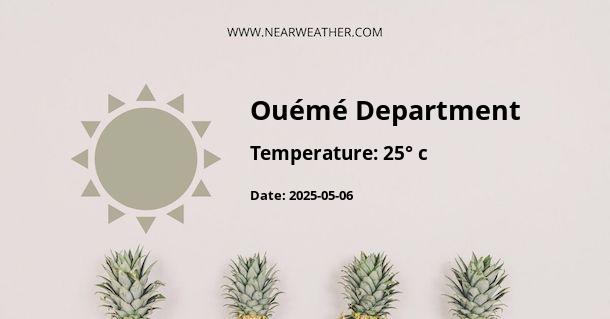Climate and Weather in the Ouémé Department, Benin
The Ouémé Department is located in the southern part of Benin, in West Africa. It is known for its diverse landscapes, rich culture, and vibrant communities. Understanding the climate and weather patterns of the Ouémé Department is essential for residents, tourists, and businesses operating in the region. This article provides a comprehensive overview of the climate and weather conditions in the Ouémé Department throughout the year.
Geography and Topography
The Ouémé Department is characterized by a varied topography, with a mix of plains, plateaus, and hills. It is situated in the coastal zone of Benin, bordered by the Atlantic Ocean to the south. The Ouémé River, one of the major rivers in Benin, flows through the department, providing water for irrigation and supporting agriculture.
Climate Classification
The Ouémé Department falls within the tropical savanna climate zone, also known as Aw according to the Köppen climate classification system. This climate is characterized by distinct wet and dry seasons throughout the year.
Temperature
The Ouémé Department experiences high temperatures throughout the year, with little variation between seasons. The average annual temperature ranges from 25 to 30 degrees Celsius (77 to 86 degrees Fahrenheit). The hottest months are typically from December to March, with temperatures often reaching above 35 degrees Celsius (95 degrees Fahrenheit).
In contrast, the coolest months are from July to September, with average temperatures dropping to around 23 degrees Celsius (73 degrees Fahrenheit). However, it's important to note that even during the cooler months, temperatures can still be quite warm compared to temperate regions.
Rainfall
The Ouémé Department experiences a distinct wet season and dry season. The wet season typically starts in April and lasts until October, while the dry season occurs from November to March.
During the wet season, the Ouémé Department receives significant rainfall, with an average annual precipitation of around 1,200 to 1,500 millimeters (47 to 59 inches). The highest rainfall amounts are usually recorded in July and August.
Conversely, the dry season is characterized by minimal rainfall, with average monthly precipitation ranging from 10 to 50 millimeters (0.4 to 2 inches). The driest months are often December and January.
Humidity
The Ouémé Department experiences high humidity levels throughout the year, particularly during the wet season. The relative humidity can reach as high as 90% during this period, creating a humid and tropical environment.
Wind Patterns
The Ouémé Department is influenced by the prevailing winds in the region. The Harmattan wind, originating from the Sahara Desert, blows from the northeast between November and February. This dry and dusty wind can lower temperatures and visibility in the area.
During the wet season, the prevailing winds shift to a more southerly direction, bringing moisture and contributing to the heavy rainfall experienced in the region.
Impacts on Agriculture and Economy
The climate and weather conditions in the Ouémé Department have a significant impact on the local agriculture and economy. The presence of the Ouémé River and fertile soils provides favorable conditions for agricultural activities.
The wet season is crucial for crop cultivation, as it ensures sufficient water supply for irrigation and plant growth. Farmers in the Ouémé Department primarily cultivate crops such as maize, yams, cassava, and rice, which are well-suited to the region's climate and soil conditions.
However, excessive rainfall or droughts can adversely affect agricultural productivity. Flooding during the wet season can destroy crops and infrastructure, while droughts during the dry season can lead to water scarcity and reduced crop yields.
The Ouémé Department also benefits from its proximity to the coast, which supports fishing activities and the development of small-scale industries such as fish processing and salt production.
Conclusion
The Ouémé Department in Benin experiences a tropical savanna climate, characterized by high temperatures, distinct wet and dry seasons, and high humidity levels. Understanding these weather patterns is essential for residents, tourists, and businesses operating in the region. The climate plays a crucial role in shaping the local agriculture and economy, with the wet season supporting crop cultivation and the dry season providing favorable conditions for fishing activities and small-scale industries.
A - Ouémé Department's Latitude is 6.666670 & Longitude is 2.500000.
A - Weather in Ouémé Department is 27° today.
A - Climate Conditions in Ouémé Department shows overcast clouds today.
A - Humidity in Ouémé Department is 72% today.
A - Wind speed in Ouémé Department is 8.03 km/h, flowing at 208° wind direction. today.
